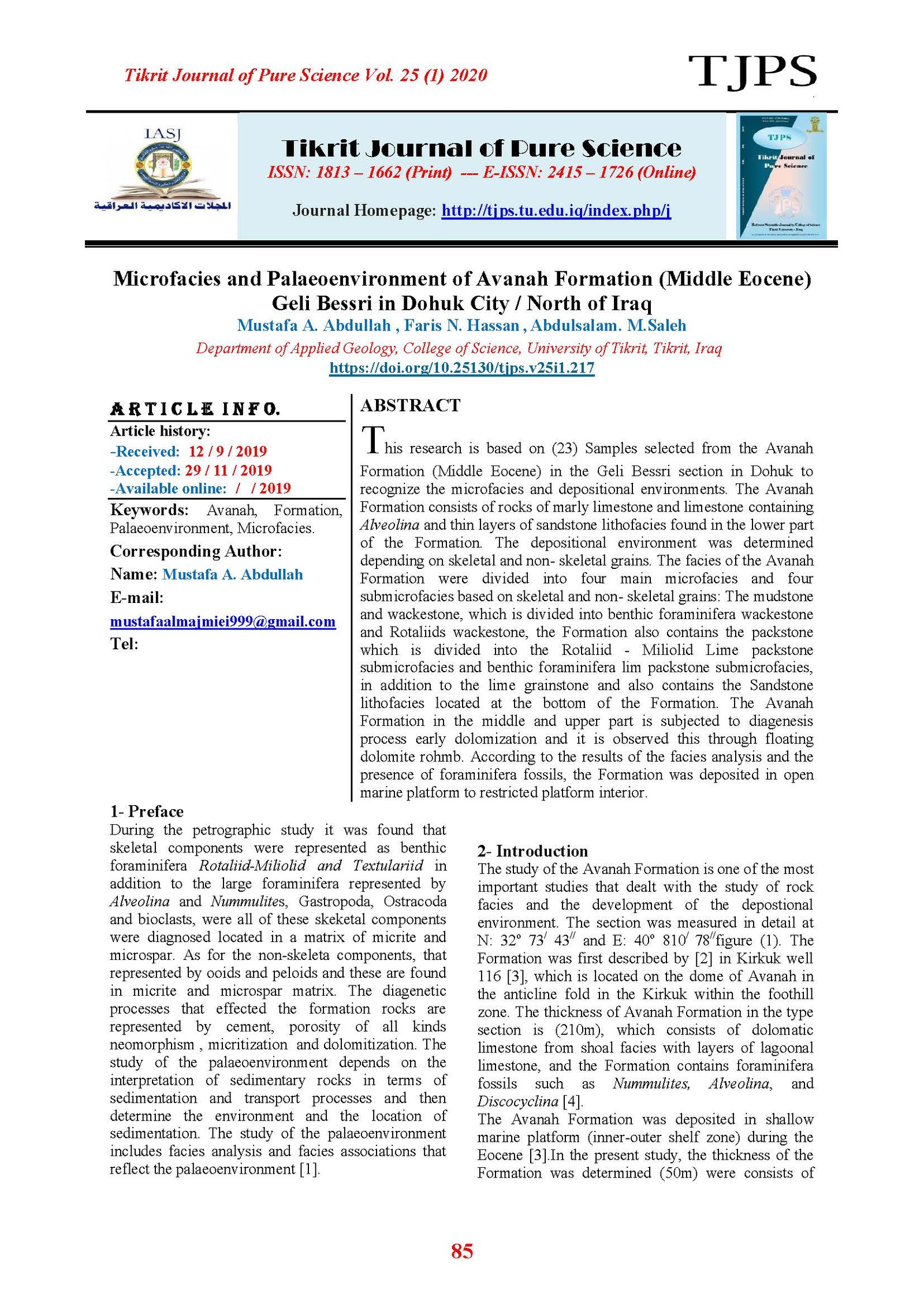Microfacies and Palaeoenvironment of Avanah Formation (Middle Eocene) Geli Bessri in Dohuk City / North of Iraq
Main Article Content
Abstract
This research is based on (23) Samples selected from the Avanah Formation (Middle Eocene) in the Geli Bessri section in Dohuk to recognize the microfacies and depositional environments. The Avanah Formation consists of rocks of marly limestone and limestone containing Alveolina and thin layers of sandstone lithofacies found in the lower part of the Formation. The depositional environment was determined depending on skeletal and non- skeletal grains. The facies of the Avanah Formation were divided into four main microfacies and four submicrofacies based on skeletal and non- skeletal grains: The mudstone and wackestone, which is divided into benthic foraminifera wackestone and Rotaliids wackestone, the Formation also contains the packstone which is divided into the Rotaliid - Miliolid Lime packstone submicrofacies and benthic foraminifera lim packstone submicrofacies, in addition to the lime grainstone and also contains the Sandstone lithofacies located at the bottom of the Formation. The Avanah Formation in the middle and upper part is subjected to diagenesis process early dolomization and it is observed this through floating dolomite rohmb. According to the results of the facies analysis and the presence of foraminifera fossils, the Formation was deposited in open marine platform to restricted platform interior.
Article Details

This work is licensed under a Creative Commons Attribution 4.0 International License.
Tikrit Journal of Pure Science is licensed under the Creative Commons Attribution 4.0 International License, which allows users to copy, create extracts, abstracts, and new works from the article, alter and revise the article, and make commercial use of the article (including reuse and/or resale of the article by commercial entities), provided the user gives appropriate credit (with a link to the formal publication through the relevant DOI), provides a link to the license, indicates if changes were made, and the licensor is not represented as endorsing the use made of the work. The authors hold the copyright for their published work on the Tikrit J. Pure Sci. website, while Tikrit J. Pure Sci. is responsible for appreciate citation of their work, which is released under CC-BY-4.0, enabling the unrestricted use, distribution, and reproduction of an article in any medium, provided that the original work is properly cited.
References
[1] Nichols, G.(2009). Sedimentology and stratigraphy. 2th edn., UK: Wiley- Blackwell Publishing Company: 419 PP.
[2] Bellen, R. C. Van, Dunningtion, H. V., Wetzel, R. and Morton, D. M. (1959). Lexique Stratigraphique International, ASIE, Vol. 111 , Fascicule 109 , Iraq.
[3] Sherbazheri,k. (1983). Study of foraminifera and microfacies of the Avanah Limestone(Middle Eocene), Dohuk Area-North Iraq. M.Sc. thesis, Mosul University, Mosul, Iraq: 103pp.
[4] Jassim, S.Z. and Buday, T. (2006a). Late Turonian – Danian Megasequence (AP 9) In: Jassim, S.Z and Goff, J.C. (eds.),Geology of Iraq. Publ. Dolin. Prague and Moravian Museum. Brno: 141-151.
[5] Hallock, p and Clenn, E.C. (1986). Larger foraminifera: a tool for paleoenvironmental analysis of Cenozoic carbonate depositional facies. Palaois, 1:55-64.
[6] Al-Alawi, M. N. (1980). Structural study of Upper Cretaceous and Tertiary Section in Jabl Bekhair Dohuk area . North. M.Sc. thesis, Mosul University, Mosul, Iraq: 203pp.
[7] Jassim , S. Z and Goff, J.C. (2006). Geology of Iraq. Published by Dolin, Prague and Moravian Mus. Brno: 314 pp.
[8] Friedman, G.M.(1969). Identification of carbonate minerals by staining methods. Journal of Sedimentary Research, 29 (1):87-97.
[9] Dunham, R.J. (1962). Classification of carbonates rocks according to the depositional texture. In: Ham, W. E. (eds.), Classification of carbonate rock. American Association of Petroleum Geologists, Memoir:108 – 121.
[10] Wilson, J. L.(1975). Carbonate facies in geologic history. Springer – Verlag, Berlin: 471 pp.
[11]Flugel, E. (2004). Microfacies of carbonate rocks, analysis, interpretation and application. Berlin: Springer: 976 pp.
[12]Tucker, M.E. (2001). An Introduction to the Origin of Sedimentary Rock. 3thedn., UK: Black well Science: 262pp.
[13] Randazzo, A. F. and Zachos, L. G. (1984). Classification and description of dolomite fabrics of rocks from the Floridian aquifer. Sedimentary Geology, 37: 151 – 162.
[14] Ghose, B. K. (1977). Palaeoecology of the Cenozoic reefal foraminifera and algae - a brief review, Palaeogeography, Palaeoclimatology, Palaeoecology , 22: 231 - 256.
[15] Brasier, M.D. (1980). Microfossils. London: George Allen and Unwin Ltd:193 pp.
[16] Milliman, J.D. (1974). Marine carbonate. New York: Springer - Verlag Berlin, Heidelberg: 375 pp.
[17] Scholle, P.A. and Ulmer-Scholle, D.C. (2003). Acolor Guide to the Petrography of Carbonate Rock : Grains, Textures, Porosity, Diagenesis, A.A.P.G. Men.-77., U.S.A: Tulsa, Okla: 474 pp.
[18] Flügel, E. (2010). Microfacies of Carbonate Rocks: Analysis, Interpretation and Applications. 2th edn., Berlin : Springer-Verlag:1006 pp.
